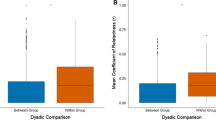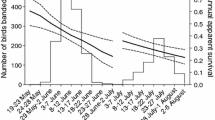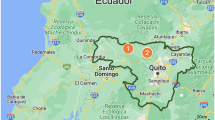Abstract
We describe the case of an unusually large capercaillie Tetrao urogallus clutch consisting of 12 eggs, of which four chicks hatched. Eight eggs died in an early stage of development. Genetic analyses revealed that the putative mother of the chicks was different from the one laying the unhatched eggs. We compare our results with reports from clutches elsewhere and conclude that nest site adoption is a likely explanation for joint clutches in grouse.
Similar content being viewed by others
References
Beauchamp G (1997) Determinants of intraspecific brood amalgamation in waterfowl. Auk 114:11–21
Bjorn TH, Erikstad KE (1994) Patterns of intraspecific nest parasitism in the high arctic common eider (Somateria mollissima borealis). Can J Zool 72:1027–1034
Borchtchevski VG (1993) Population biology of the capercaillie. Principles of the structural organisation. Izdatelstvo Tsnil ochotnitshjego chosjaistva i zapovednikov, Moscow
Bustnes J, Erikstad KE (1991) Parental care in the common eider (Somateria mollissima): factors affecting abandonment and adoption of young. Can J Zool 69:1538–1545
Couturier M, Couturier A (1980) Les coqs de bruyère, vol 1. Grenoble, France
Eadie JMcA, Kehoe FP, Nudds TD (1988) Pre-hatch and post-hatch brood amalgamation in North American Anatidae: a review of hypotheses. Can J Zool 66:1709–1721
Eberhard JR (1996) Nest adoption by monk parakeets. Wilson Bull 108:374–377
Erskine AJ (1990) Joint laying in Bucephala ducks—“parasitism” or nest site competition?. Ornis Scand 21:52–56
Filchagov AV (1996) Two clutches of willow grouse in the same nest. Gibier Faune Sauvage 13:75–78
Kenaga EE (1997) Brood parasitism among birds. Birding 29:392–401
Klaus S, Andreev AV, Bergmann HH, Müller F, Porkert J, Wiesner J (1989) Die Auerhühner. Die Neue Brehm-Bücherei, Band 86. Westarp Wissenschaften, Magdeburg
Klaus S, Bergmann HH, Marti C, Müller F, Vitovic OA, Wiesner J (1990) Die Birkhühner. Die Neue Brehm-Bücherei. Westarp Wissenschaften, Magdeburg
Lank DB, Bousfield MA, Cooke F, Rockwell FR (1991) Why do snow geese adopt eggs? Behav Ecol 2:181–187
MacWhirter RB (1989) On the rarity of intraspecific brood parasitism. Condor 91:485–492
Maxson SJ (1978) Evidence of brood adoption by ruffed grouse. Wilson Bull 90:132–133
McRae SB (1995) Temporal variation in responses to intraspecific brood parasitism in the moorhen. Anim Behav 49:1073–1088
Menoni E (1991) Écologie et dynamique des population du grand tétras dans les Pyrénées, avec des references speciales a la biologie de la réproduction chez les poules - quelques application a sa conservation. PhD thesis, University of Toulouse
Müller F (1973) Auerhuhn. In: Glutz von Blotzheim G (ed) Handbuch der Vögel Mitteleuropas.Galliformes und Gruiformes, Band 5. Akademische Verlagsgesellschaft. Frankfurt am Main, pp 172–225
Payne RB (1998) Brood parasitism in birds: strangers in the nest. Bioscience 48:377–386
Petrie M, Møller AP (1991) Laying eggs in others’ nests: intraspecific brood parasitism in birds. Trends Ecol Evol 6:315–320
Robertson GJ (1998) Egg adoption can explain joint egg-laying in common eiders. Behav Ecol Sociobiol 43:289–296
Robertson GJ, Watson MD, Cooke F (1992) Frequency, timing and costs of intraspecific nest parasitism in the common eider. Condor 94:871–879
Segelbacher G (2002a) Non-invasive genetic analysis in birds: testing reliability. Mol Ecol Notes 2:367–369
Segelbacher G (2002b) Genetic structure of capercaillie populations: a non-invasive approach at multiple spatial scales. PhD thesis, Technische Universitat Munich
Segelbacher G, Paxton RJ, Steinbrueck G, Trontelj P, Storch I (2000) Characterisation of microsatellites in capercaillie (Tetrao urogallus) (AVES). Mol Ecol 9:1934–1935
Sorenson MD (1991) The functional significance of parasitic egg laying and typical nesting in redhead ducks: an analysis of individual behaviour. Anim Behav 42:771–796
Spidsø TK, Wegge P, Storaas T (1985) Renesting in Capercaillie in southern Norway. In: Hudson P, Lovel TWI (eds) Proceedings international symposium on grouse 3. World Pheasant Association, Reading, pp 278–288
Storch I (1991) Habitat fragmentation, nest site selection, and nest predation risk in capercaillie. Ornis Scand 22:213–217
Storch I (1994) Habitat and survival of Capercaillie nests and broods in the Bavarian Alps. Biol Conserv 70:237–243
Wegge P (1985) Spacing patterns and habitat use of capercaillie hens in spring. In: Proceedings international symposium on grouse 3. World Pheasant Association, Reading, pp 261–274
Weigmann C, Lamprecht J (1991) Intraspecific nest parasitism in bar-headed geese, Anser indicus. Anim Behav 41:677–688
Westemeier RL, Buhnerkempe JE, Edwards WR, Jeffrey JD, Scott SA (1998) Parasitism of greater prairie-chicken nests by ring-necked pheasants. J Wildl Manag 62:854–863
Acknowledgements
We thank Peter Kuske for showing us the nest and for sharing his observations with us. Vladimir Borchtchevski, Larry Ellison, Ariane Laurent-Bernard, Emmanuel Ménoni, Jimmy Oswald, Per Wegge, Tomas Willebrand, and Tor Spidsö reported their experience with unusual grouse clutches to us. Jevgeni Shergalin helped with translation of Russian literature.
Author information
Authors and Affiliations
Corresponding author
Rights and permissions
About this article
Cite this article
Storch, I., Segelbacher, G. Two grouse clutches in the same nest: evidence for nest site adoption in capercaillie (Tetrao urogallus). J Ornithol 146, 85–88 (2005). https://doi.org/10.1007/s10336-004-0064-3
Received:
Revised:
Accepted:
Published:
Issue Date:
DOI: https://doi.org/10.1007/s10336-004-0064-3




